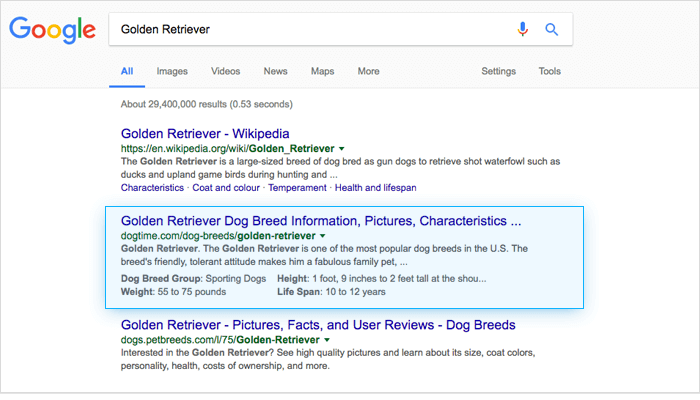I remember being awestruck back in 2013 by Brian Dean’s list of more than 200 Google ranking factors. My first thought was, “Wow! Think of the work and research that went into this!” followed by, “This will be so useful!” and finally, “Oh god, there aren’t enough hours in the day for all of this.”
Fortunately, not all ranking factors are created equal — you can maximize your SEO efforts by focusing on a few specific ranking factors. Of course, Google’s algorithm is always changing, and we can’t rely on yesterday’s ranking factors. These top four ranking factors are based on the most recent studies by SearchMetrics, >Backlinko, and my colleagues at SEO PowerSuite.
Read on to discover how to optimize your site for today’s important signals.
1. Content
Content is one of the most important Google ranking factors, according to Andrey Lipattsev, a Search Quality Senior Strategist at Google. This shouldn’t be news — content has been an important ranking factor for a while — but in recent years, we’ve seen a shift away from keyword-focused content towards more relevant content written in natural language.
In fact, the SearchMetrics study cited above found that just 53% of the top 20 queries have keywords in their title tag, and less than 40% of landing pages have keywords in their H1. This number is dropping year-over-year, which “clearly demonstrates that Google evaluates content according to its relevance—and not by the inclusion of individual keywords.”
So what exactly does “relevant” content look like? The short answer is: comprehensive.
Consider the top result when you Google “Golden Retriever”:

DogTime’s article on Golden Retrievers rings in at almost 3,500 words, and it covers everything including breed characteristics, history, personality, health, care, and even rescue groups. The page also includes multiple images, infographics, and embedded videos — it’s everything you could ever want to know about Golden Retrievers on one page.
This supports what Backlinko found: Semantic search is here to stay. Algorithm updates like Hummingbird and RankBrain place intense value on semantic relevance and optimization, meaning that an in-depth examination of one topic in easy-to-understand language will always beat out unreadable keyword-dense drivel.
Backlinko also found that long-form content ranks better than short-form content, probably because it allows articles to consider their subject in more detail. That said, SearchMetrics found that mobile content is usually only 2/3 the length of desktop content, and mobile use is on the rise.
How to optimize:
Content influences a variety of other ranking factors, such as bounce rate and CTR. So for best results, make sure your content is both comprehensive and relevant to your audience — an in-depth examination of flamenco dancing probably won’t do much for your auto-repair business.
I recommend you use content auditing software to:
- Find and fix thin content.
- Explore fewer topics in greater detail on each page.
- Improve your Topical Authority in your niche.
2. Backlinks
Backlinks remain an important Google ranking factor, but over the years, Google has learned to weed out the bad links from the good. More links will still result in a higher score, but only if they’re from a number of diverse and authoritative domains.
The key to a strong link building campaign is to create content people crave, and then to promote that content relentlessly. When other industry authorities read and link to your content, Google will read your backlink’s matching anchor text and consider your content more relevant.
When your content earns a lot of these high-quality backlinks, you hit three important ranking signals: number of backlinks, link authority, and link diversity.
Note that one of the main roles of social signals is to win you more high-quality backlinks. SearchMetrics found that ranking position and social signals strongly correlated across all social media channels — though Facebook is still the platform with the highest concentration of user interactions.
How to optimize:
There are many different ways to approach link building, but what they all boil down to is content marketing. Step one: Create high-quality content. Step two: Promote.
If you’re not sure where to start, I recommend reading this article by Anna Crowe on important link building strategies. If you’re having trouble coming up with original content, consider using the Skyscraper link building technique: Find someone else’s relevant content with lots of backlinks, improve upon their content with a more detailed article, and then share your content.
I also recommend you use link auditing software to get a better picture of your link profile. Use this software to:
- Monitor how many links your content has and the quality of those links.
- Reach out to high-quality partners for backlinks.
- Eliminate spammy and low-quality links; disavow them if you can’t get them removed.
3. Mobile-First User Experience
One of the biggest changes we saw in 2016 was Google’s shift towards mobile-first indexing. This means that Google’s index will now primarily crawl the mobile version of websites as opposed to the desktop version.
Mobile optimization is an extremely important ranking factor. All of the top 100 most visible domains have mobile-friendly solutions, according to SearchMetrics.
Today, it will be more important than ever that your content is responsive on all mobile platforms and identical to the content on your desktop site. Mobile-friendliness is now the norm, and with 85% of all websites now meeting Google’s criteria for being mobile-friendly, it’s time to improve your website even more — think mobile-first, not just mobile-friendly.
A word of warning: according to Google, if you are in the process of building a mobile version of your site, don’t launch it until it’s finished. Releasing a broken or incomplete mobile version of your website might wind up hurting your ranking more than helping; it’s better to keep your website desktop-only until the mobile version is ready.
Page speed is another important ranking factor that ties heavily into a good user experience. Desktop websites should load in 3 seconds or less, while mobile websites should load in 2 seconds or less (according to SearchMetrics, the top-ranked mobile websites are approximately one second quicker than their desktop equivalents).
How to optimize:
- Use Google Search Console to add and verify the mobile version of your website.
- Use the Structured Data Testing Tool to ensure that the same structured markup exists on both your desktop and your mobile site.
- Ensure that your mobile site is accessible to Googlebot using the txt testing tool.
- Test your page speed using PageSpeed Insights. If your page is slow, use an auditing tool to find and fix uncompressed content, page errors, and other elements slowing your website down.
4. Other Technical Factors
There are many other technical factors which might play a big role in your website’s rank. These factors include:
Encryption: Backlinko still finds a strong correlation between HTTPS websites and first page Google rankings, and SearchMetrics confirms that 45% of the top websites all use HTTPS encryption (up from 12% in 2015). Google confirmed back in 2014 that websites with a strong HTTPS encryption will rank better than their HTTP counterparts, and websites that have not switched to HTTPS are now marked as unsafe in Google Chrome.
H1 and H2 Headings: There are more landing pages with an H1 and H2 in the source code this year. SearchMetrics found a strong correlation between the use of at least one H2 and a higher rank.
Anchor text: Exact-match anchor text still has a strong influence on rankings, but you risk a Penguin penalty if your links appear unnatural or spammy. Make sure your backlink anchor text is diverse and organic.
 Interstitials: In keeping with Google’s emphasis on mobile-first optimization, they’re cracking down on intrusive interstitial pop-ups. That means any page with an ad or CTA that covers the main content or whisks users to a new page upon clicking might suffer a penalty. Exceptions to this include login dialogs, small banners that are easy to dismiss, and legally-required interstitials (e.g. age verification).
Interstitials: In keeping with Google’s emphasis on mobile-first optimization, they’re cracking down on intrusive interstitial pop-ups. That means any page with an ad or CTA that covers the main content or whisks users to a new page upon clicking might suffer a penalty. Exceptions to this include login dialogs, small banners that are easy to dismiss, and legally-required interstitials (e.g. age verification).
How to optimize:
- Switch to HTTPS encryption.
- Make use of H2 headings, especially if the top URLS in your niche don’t.
- Ensure that your anchor text is diverse and semantically relevant.
- Remove all intrusive interstitials from your mobile website.
Conclusion
SEO is an ever-evolving industry. In the past few years, we’ve seen Google make a steady push for rich content, quality links, and a perfect mobile experience. Other ranking factors are certainly important and will play a role in your rankings, but if you prioritize improving elements of your website related to these factors, then you’ll come out ahead of the competition.
Images are by the author.





